Kapitan chicken, also known as Ayam Kapitan in Malay, is an authentic Nyonya chicken curry that blends the rich culinary traditions of Malay and Chinese cultures. It is the least spicy Malaysian curry, ideal for anyone unable to bear the heat from other fiercely hot curries.
This article will detail how to make this Nyonya chicken curry, step-by-step..
Note: This post may contain affiliate links. Please read my privacy policy for more info. I may receive commissions for purchases made through links in this post. As an Amazon Associate, I earn from qualifying purchases.
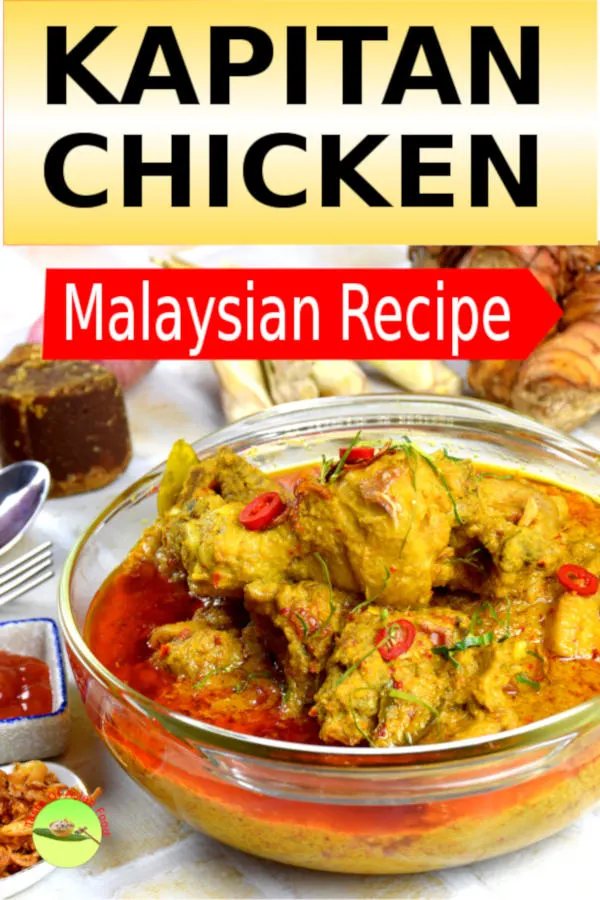
Key ingredients required to prepare kapitan chicken
- Chicken. I use bone-in, skin-on chicken pieces for this recipe. The bones add extra flavor during the stewing process, which is why they are important. If you choose not to use bone-in chicken, you can substitute it with boneless chicken. In that case, I recommend replacing part of the water used for stewing with chicken broth to enhance the flavor.
- Turmeric powder. Turmeric powder is used to marinate the chicken and give it a yellow color. It is commonly used in Chinese cooking, including making Nyonya chicken curry.
- Fresh ginger, galangal, lemongrass, and fresh turmeric. These four ingredients create the unique flavor of Kapitan Chicken. When I cannot find fresh turmeric, I substitute it with turmeric powder.
- Candlenuts. The primary use of candlenuts is to thicken the gravy. If candlenuts are unavailable in your area, you can substitute with cashew nuts instead.
- Chilies. I use two different types of chilies in this recipe. Combining dried chilies and fresh red chilies will provide the best flavor, as each has its unique taste. If you cannot handle the heat of the chilies, I recommend removing the seeds and the pith rather than reducing the number of chilies, as reducing the quantity will diminish the dish’s overall flavor.
- Belacan. Belacan is a unique ingredient used in Nyonya chicken curry. It is a type of shrimp paste popular in Malaysia. A close substitute for belacan is Thai shrimp paste. It is available in most Asian grocery stores and online at Amazon.
- Palm sugar is derived from the coconut palm flower’s sap. It is close to brown sugar but has a more intense caramel flavor. It usually sells as a small cylinder block about ten-centimeter height. Shave off the required amount of palm sugar from the cylinder block with a knife and add to the stew. It helps to balance the sour flavor of tamarind. You can use brown sugar as a substitute.
- Tamarind juice. Tamarind juice is made by adding warm water to the tamarind pulp and letting the pulp dissolve into the water. Set aside ten minutes, and then filter the pulp and seeds away. Use only the extracted juice. You can use tamarind concentrate (or tamarind paste) as a substitute for fresh tamarind pulp. Another substitute is Assam Keping (also called Assam Jawa). We can get it anywhere in Malaysia and Indonesia. However, it may be hard to get outside the South-East Asia region.
- Coconut cream. I can get freshly squeezed coconut cream at the market. Fresh coconut cream tastes better and has a better aroma than the canned version. But if it is unavailable, use the canned or boxed version as the alternative. Check the content of the coconut cream. It should have at least twenty percent of fat. Ensure you get the coconut cream for cooking and not the coconut milk for drinking.
- Fried shallot and kaffir lime leaves. Sprinkle fried shallots on top of the curry before serving to enhance the flavor. You can make it yourself by following this recipe or purchase online. Kaffir lime leaves are considered more exotic outside of Asia. If you find them, cut the leaves into fine strips and add them to the curry, cooking for half a minute before serving. They impart a lemony flavor and can be used as a garnish placed on top before serving.
Note: Galangal is also called blue ginger, and turmeric is called yellow ginger in Chinese.
How to cook Kapitan Chicken
Here are the detailed instructions on how to prepare Kapitan chicken.
Step 1- Marinate the chicken
- Cut the chicken into large chunks, bone-in, and skin-on. The chicken pieces should be marinated with ground turmeric, salt, and vegetable oil for at least 30 minutes or a few hours. You can purchase the whole chicken and cut it into large chunks, or only use chicken thighs or chicken breasts.
- I marinate the chicken with all the salt required for the recipe. The chicken will not be too salty as part of the salt will eventually dissolve into the stewing liquid.
Tip: Use a disposable hand glove when you marinade the chicken, as the turmeric will leave a yellow stain on your hand.
Step 2: Deep Frying
- Deep-fry the chicken chunks until the skin turns brown, which will take a minute or two in the hot oil at 190°C/375°F. Deep-frying creates the aroma through the Maillard reaction.
- Remove the chicken chunks from the oil once it turns brown. It does not matter if they are still half-cooked, as we will continue cooking the chicken with the curry paste and the coconut milk for another thirty minutes.
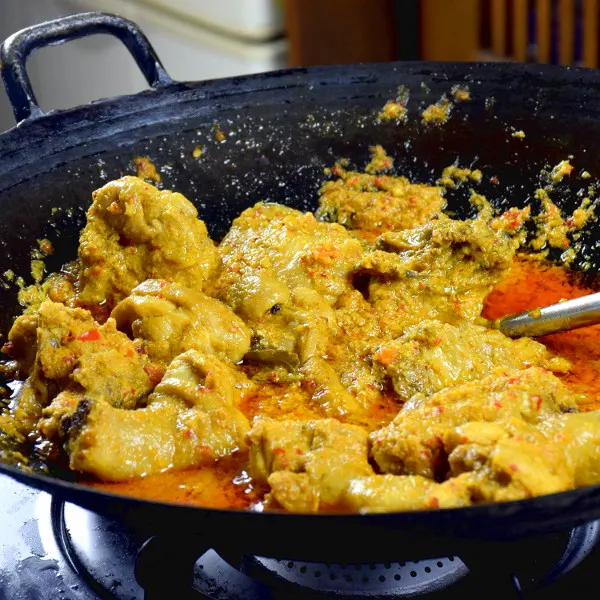
Step 3- Prepare the ingredients for the curry paste
Blend all the ingredients below to form the curry paste
- Cut the onions into large pieces, and remove the skin of the whole garlic clove. We use red onions to make the curry, but yellow onions are equally good.
- Remove the outer layer of the lemongrass, discard the green section, and use the white bulb only. Cut the white section of the lemongrass into short sections. Most household blenders can handle lemongrass with ease.
- Galangal is much harder than ginger and lemongrass. Therefore, the food processor may not blend the large pieces effectively into a paste. You can finely dice or cut it into thin slices to blend well with the softer ingredients. The curry will taste good if it is smooth and without the remnant of the large pieces of galangal.
- Soak the dry chilies in hot water for about 15 minutes or until it is soft, and cut them into short pieces. Remove the seeds from the red chilies. Cut them into short pieces.
- Cut the turmeric into slices (use your glove ).
- Drop a piece of belacan and the candlenuts into the blender. Candlenuts are not that hard. You can add the candlenuts to the food processor along with other ingredients. You can also crush them and add them to the stew directly.
Blend these items until homogeneous and become a fine paste. After cooking, you may experience some small pieces of galangal and lemongrass remaining in the gravy if you do not blend the paste until it is smooth enough.
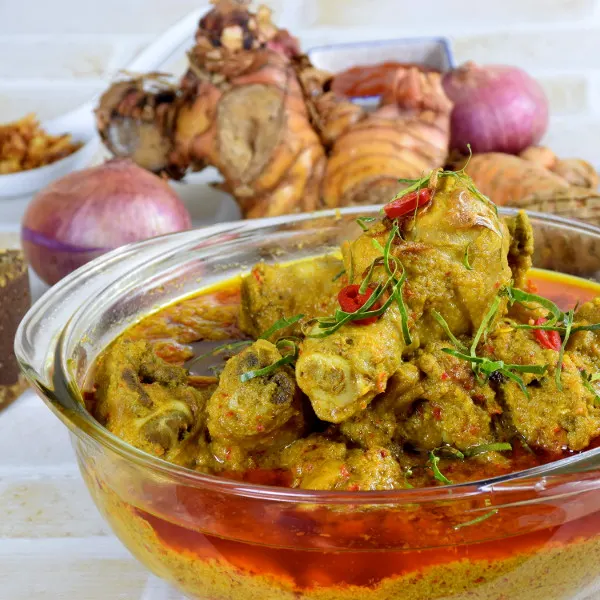
Step 4- Put it all together and cook.
The cooking part of this recipe is simple once you have all the ingredients ready.
- Saute the curry paste with vegetable oil in a wok over medium heat until it turns aromatic. It may take five to ten minutes. By then, the red chili oil will separate from the paste.
- Add the coconut milk to the sauteed curry paste to form a thin gravy.
- Next, add the kaffir lime leaves, tamarind juice, and palm sugar.
- Add the chicken to the curry paste and cook for 30 minutes until the chicken chunks are cooked thoroughly. You may want to add some water if it is too dry.
- Dish out and serve. Garnish with cut red chilies, lime juice, and thin strips of kaffir lime leaves. It is best served with white rice or roti jala.
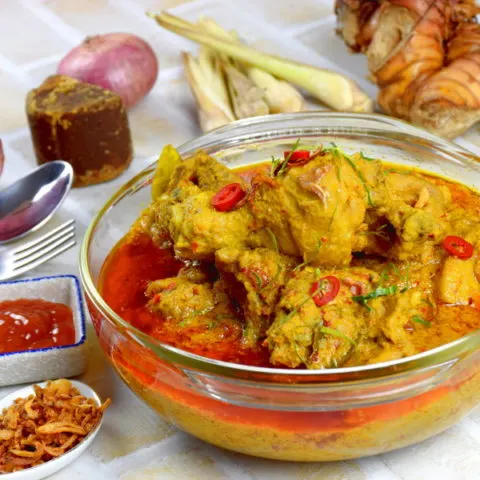
Kapitan Chicken recipe
Kapitan chicken (Ayam Kapitan in Malay) is truly a Malaysian curry, the result of the amalgamation of the diverse array of Malay, Chinese and Indian eating culture.
Ingredients
A
- 1 kg chicken, bone-in, skin-on, large chunks
- 1/2 tablespoon ground turmeric
- 4 teaspoons salt
- 1 teaspoons vegetable oil
B
- 150 g onions
- 2 cloves garlic
- 10 g ginger
- 20 g galangal
- 10 g turmeric
- 4 candlenuts
- 65 g lemongrass, weight for white section only
- 4 dry red chili, soak in water until soft
- 40 g red chili, (serrano chili)
- 4 g belacan
- 4 tablespoons vegetable oil
C
D- Garnish
- fried shallots
- kaffir lime leaves, finely slices
- red chilies, cut into small pieces
Instructions
- Wash and cut the chicken into large pieces (bone-in, skin-on)
- Marinate the chicken with turmeric powder, salt, and vegetable oil. Stand for at least 30 minutes or longer.
- Deep fry the chicken pieces until the skin turns brown. Remove and set aside.
- Cut all the ingredients in (B) into small pieces. Blend until it forms a homogeneous paste with a food processor.
- Saute the curry paste in a wok until fragrant.
- Add the chicken, coconut cream, kaffir lime leaves, tamarind juice, and palm sugar into the wok.
- Simmer over low heat for 20 minutes or until the chicken is fully cooked
- Dish out and garnish with fried shallots, red chilies, and finely sliced kaffir lime leaves,
Recommended Products
As an Amazon Associate and member of other affiliate programs, I earn from qualifying purchases.
Nutrition Information:
Yield: 4 Serving Size: peopleAmount Per Serving: Calories: 1173Total Fat: 77gSaturated Fat: 23gTrans Fat: 0gUnsaturated Fat: 49gCholesterol: 235mgSodium: 2329mgCarbohydrates: 58gFiber: 5gSugar: 41gProtein: 65g
This data was provided and calculated by Nutritionix on 3/22/2019
Tips to make the best Kapitan Chicken
- Turmeric has an intense yellow color that can stain your hand. Use a pair of disposable gloves when you cut the turmeric. It can stain your fingers as well as any plasticware. Use ceramic or glassware whenever you want to marinate the chicken with turmeric.
- There is NO substitute for the aroma of kaffir lime leaves. You have to omit it if it is not available.
- Fresh turmeric is always the better choice. However, since you need to use ground turmeric to marinate the chicken, you may want to use it for the whole recipe. Use only half of the amount of fresh turmeric powder if you decide to use the fresh one.
- You can substitute half of the coconut milk with plain yogurt. Some people want to be healthier and prefer to use less coconut milk. I use coconut milk solely as this is the original way to prepare Kapitan Chicken.
- There is an easy way to cut the kaffir lime leaves into fine strips. To do this, stack up a few pieces of the leaves, roll them up tightly, and cut them into fine strips.
- You can also bash the lemongrass and stew it with the chicken to extract its flavor. The bashed lemongrass should be decarded before serving. I do this in my rendang recipe, but I will now include the lemongrass in the curry paste.
Kapitan chicken differs from the Malay and Indian curry as it is not only cooked with less chili, but the common herbs in Indian curries, such as cumin, fenugreek, and fennel, are hardly used. Instead, a small amount of belacan and turmeric are added with abundant coconut milk.
The Legend of Kapitan Chicken
The name Kapitan Chicken (Captain’s Chicken) is derived from a fun legend from the British colony in Malaysia.
According to Malaysian history, legend has it that a Chinese chef on a ship owned by the British was eager to learn how to cook the local cuisine. One day, he saw a Malay woman preparing a stewed chicken dish in the kitchen with an unfamiliar, exotic flavor. He asked the woman if she would share her recipe, and she obliged. The woman told him it was a chicken curry dish and graciously showed him the cooking method.
Returning to his kitchen, he realized it could be too spicy for the British captain and the crew members. He improvised the recipe by drastically reducing the spiciness and enhanced with some Chinese ingredients. His toned-down version of the curry received raved reviews from the captain and his guests.
When the captain asked him what the name of this dish was, he was caught off guard by murmuring, “Ayam Kapitan,” which means captain’s chicken in Malay. The name has since stuck with this dish among the locals until today.

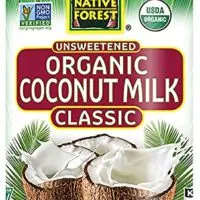
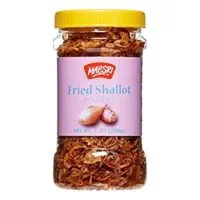
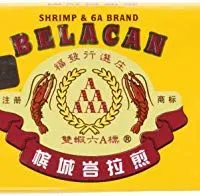
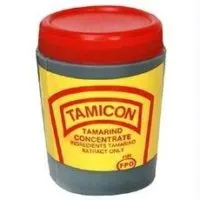
Chicken chop – How to make the best Malaysian chicken steak
Sunday 22nd of June 2025
[…] of the less spicy curry dishes, Kapitan Chicken, is an authentic Malaysian curry. This unique flavor of the Nyonya chicken dish results from the […]
Mats
Friday 23rd of May 2025
Delicious curry, 5* top rated. Normally I am very carefull with curcuma since because it's very powerfull taste but in this combination it really comes out wonderful, maybe because in combination with the coconut cream.
Devil's curry - how to make authentic curry debal with chicken
Tuesday 1st of April 2025
[…] Kapitan chicken is truly a Malaysian curry, amalgamating the diverse array of Malay, Chinese, and Indian eating cultures. This Nyonya chicken dish has many similarities to Devil’s chicken and is added with kaffir lime leaves and local shrimp paste called belacan.Lamb vindaloo is a classic Indian curry with an intense flavor of spices with a deep earth undertone. It is also cooked with vinegar, dried chilies, and mustard seeds, just like Devils’ chicken, due to the influence of the Portuguese way of cooking. […]
Pressure Cooker Curry Chicken: A Simple, Fast, and Delicious Recipe
Wednesday 26th of March 2025
[…] If you decide to include galangal, palm sugar, asam jawa, kaffir lime leaves, and belacan in your recipe, you’ll create a unique version of curry known as Kapitan Chicken. You can access the recipe by clicking here. […]
james
Thursday 13th of February 2025
I've often noticed chinese five spice in this recipe, I guess that's from its Peranakan roots